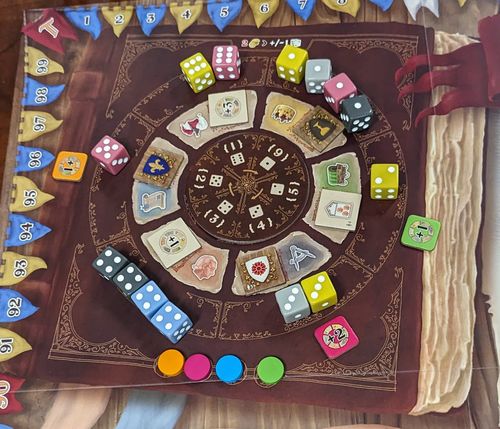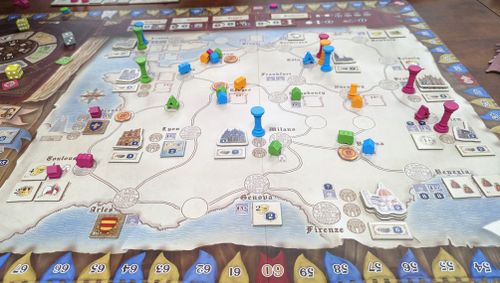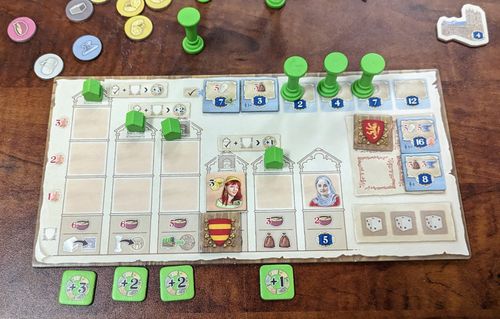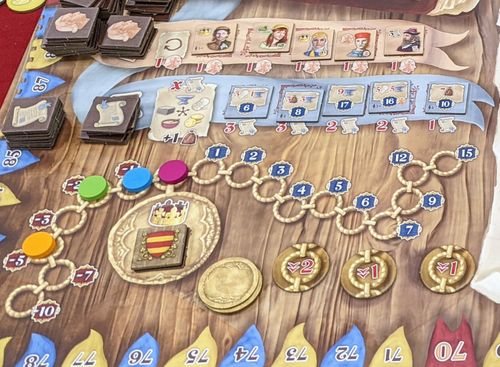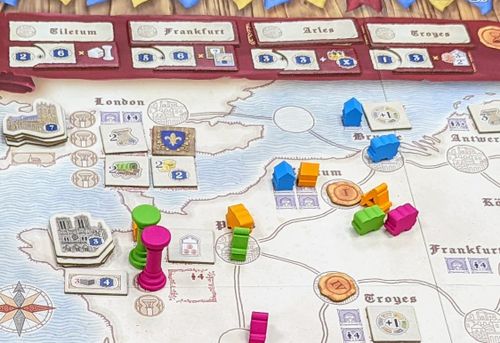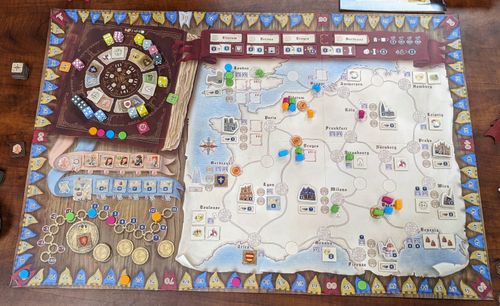When I see either Daniele Tascini or Simone Luciani‘s name on a board game, I’m instantly curious to try it since they’re both highly reputable designers and I’ve enjoyed many of their games in the past. When I see their names together on a board game, I know I’m in for a treat, considering this is the same designer duo behind Tzolk’in and The Voyages of Marco Polo. After I demoed their latest release Tiletum from Board&Dice at Gen Con 2022, I wasn’t blown away, but I thought it was a solid, classic-feeling eurogame with mostly familiar mechanisms that worked well together. It wasn’t until I played my first full game of Tiletum, where I got the full picture and my eyes and brain lit up.
In Tiletum, 1-4 players take on the roles of rich merchants traveling throughout Europe during the Golden Age of the Renaissance, gathering resources, fulfilling contracts, and competing for victory points at fairs in various towns. The gameplay for Tiletum is centered around a dice drafting, action selection mechanism where the dice have a dual function; the die you choose each turn informs which resource you gain and which action you perform.
Tiletum is played over four rounds and each round is divided into five phases: Preparation, Action, King, Fair, and Cleanup. The goal of the game is to have the most victory points by the end of the game. This is a point salad game where you get points for a lot of different things, and it’s not unlikely for scores to be in the 200+ zone by the end of the game.
In the Preparation phase, you take a number of resource dice (based on player count) from the dice sack, roll them, and place them around the action wheel according to their number. There are a total of 20 resource dice in 5 different colors corresponding to the resources in the game — gold (yellow), food (pink), wool (light gray), stone (dark gray), and iron (blue-ish gray). You get used to it, but there was often confusion with the different gray dice and the corresponding resource tokens. The action wheel has pie slices for each pip value, so when you distribute the dice, all dice with common numbers are placed in the same section of the action wheel.
In the Action phase, the heart of the game, players take turns taking a die from the action wheel, then gaining the corresponding resources provided by the die, and performing the associated action. The color and number on the die you take indicates which resource you get and how many. Then the amount of action points you get is always the difference between 7 and the number on the resource die you chose. For example, if I draft a pink “5” die, I gain 5 food tokens but, I only get 2 action points for the corresponding action. Alternatively, if I pick a yellow “1” die, I only get 1 gold token, but I get 6 action points. So already, you can probably see how there’s a lot to consider when choosing a die on your turn. You might need a certain amount of a particular resource, and at the same time you need to take a particular action, but often the stars don’t align, so you’ll need to do one or the other. That decision is often very tough, especially because your opponents will have their eyes on everything you’re considering as well.
On the action wheel, there are 5 different actions you can choose from, but there’s also a joker action space, which allows you to take any action. In addition to the interesting choices that arise from the dice distribution and actions, there are also super juicy bonus tiles placed around the action wheel at the start of each turn. There’s only 1 tile on each action space, and they’re first come, first serve. Thus, they will also factor in your decision process when you’re figuring out which die to take on your turn. As you can imagine, turn order is very important.
There are 5 main actions in Tiletum, in addition to tasks (free actions) you can take at any point during your turn. Most of the actions have a variety of ways you can allocate your action points. Again, the amount of actions points you gain depends on which die number you draft.
A big chunk of the game board represents a map of Europe, which initially gave me some Orléans vibes. Players start the game with a merchant (wagon) and an architect (pencil compass) in the Tiletum town space, and there are 2 actions that allow you to manipulate those pieces on the map. When you perform the Architect action, you can spend action points to move your architect around the map, to add a pillar from your personal supply to an empty pillar space in a town with your architect, or to take a bonus tile from the town where your architect is located. The Merchant action works similarly since you can spend action points to move your merchant, take a bonus tile, or you can place a house on an empty house space in the town where your merchant is located.
During final scoring at the end of the game, you’ll multiply the number of houses you have on the map by the number of pillars you have on the map and gain that many victory points. Also, when it comes to pillars, having pillars in towns allows you to build cathedrals which are worth a decent amount of points. On the other hand, houses are very helpful especially at fair locations, since you either need to have your merchant at the fair location or a house placed there to participate and score points. Therefore, it’s usually a good option to place houses and pillars when you can. There are limited spaces at each town, so it’s always a race to beat your opponents there.
Before I explain how the Character and Contract actions work, it’s important to note that each player has their own player board in Tiletum, which is where you’ll be managing tiles you collect as well as juggling a set collection mini game. Your player board has a warehouse section to store 4 tiles, and a main section where you can place character and crest tiles in different rows and columns. Throughout the game you’ll be picking up a variety of different bonus tiles (crests, resources, actions, etc.), as well as contract and character tiles. You can only ever have or take one type of each crest, and each column can only have one type of each character.
When you perform the Character action, you can spend action points to take character tiles from the character offer, which has 5 face-up character tiles to choose from. When you take a character tile, you immediately place it in your warehouse, so you must have an available empty space. With the Character action you can also spend an action point to discard all character tiles from the offer, and immediately refill it with new tiles. You can also spend action points to move a character tile from your warehouse into a room on your player board, noting you cannot have two different buildings (columns) with the same character. After you place a character tile, you’ll also earn the bonus in the left corner of the tile. Each player starts the game with a house at the top of each column/building, which you can add to your supply once that column/building is filled with character tiles.
When you perform the Contract action, you can spend action points to take a contract tile from the contract offer, or you can exchange your resources for different resources. The contract tiles cost a varying number of action points based on their position in the offer, and they need to be placed in your warehouse immediately, similar to character tiles. They are standard contracts where you need to spend a number of resources to fulfill them, then you gain a number of victory points. When you complete a contract, which is a task/free action, you place the contract tile in the completed contracts area of your play board, which unlocks a pillar that is added to your supply. Plus, you gain points from the contract and additional points printed on the space you placed it on.
The final action is the King action, where you can spend action points to advance on the King track. That is literally all you do action wise, so it may appear insignificant initially, but your position on this track relative to your opponents is important. During the King phase, you’ll adjust turn order based on the King track and this is a game where turn order is extremely important. It’s also worth noting that before the first player takes a die in the action phase, they will reveal the rightmost face-down corruption token under the King track and move all players markers back according to the number on the token (0, 1, or 2).
After the last player has taken their third die and has finished resolving their last action for the round, there is a King phase. In the King phase, the player whose marker is highest on the King track takes or discards the bonus tile next to the track. Then players score or lose points based on their position on the King track. Finally, turn order is adjusted so the player highest on the King track becomes the first player, the second-highest becomes the second player, and so on.
Then comes the Fair phase, where players have the opportunity to gain a decent chunk of victory points. The first fair is always in Tiletum, but the subsequent three fair locations (out of eight) are randomly selected at the beginning of the game, along with four (out of eleven) randomly selected fair tiles. The fair tiles have different scoring objectives such as scoring points for each pillar you have on the map, or for each contract you have fulfilled, or for each crest tile on your player board, or for sets of houses and pillars you have on the map, etc. The variety of combinations of fair locations and fair tiles forces you to change up your strategy each game; it makes Tiletum highly re-playable.
Everything you’re doing each game is to try to score as many points as you can at as many fairs as you can. You have this variety of different objectives that relate to a variety of different locations on the map where you need to have either a house or your merchant present the round it’s being scored to even score it. There are just so many different ways the game will push and pull you as you try to come out ahead of your opponents each game. With limited spaces for houses in each town, you have to decide when it’s worth it to move your merchant across town to make sure you can participate in the upcoming fair. Or maybe you neglect an earlier fair to get ahead of everyone for a fair in a later round which might be more rewarding. It’s really cool and very challenging!
After the Fair phase, there’s a Cleanup phase where you’ll replenish bonus tiles around the action wheel and on the King track. Then you’ll return all dice to the bag and rotate the action wheel one step clockwise before starting the next round. Rotating the action wheel each round keeps things interesting as well.
At the end of the Fair phase of the 4th round, there’s final scoring where you may earn additional points for the houses and pillars you have on the map, as well as completed buildings on your player board. You can also cash in your remaining resources and gain a point for every 4 resources. Then the player with the most victory points wins.
I glossed over crest tiles, but they also play an important role in Tiletum. You can gain crest tiles as bonus tiles or some may appear in the contract offer as well. To move them from your warehouse to the bottom of a column/building, you have to spend some amount of food, then you gain the bonus of the space you covered. You can cover up the crest spaces in any order you’d like, so if you have the right amount of food, you can strategically place one at the right time for a powerful, helpful bonus. For example, there’s one space where you can immediately move your merchant anywhere on the map. There’s also one that allows you to place a house from your supply onto any town on the map. Just imagine, your opponent could be gradually moving their merchant somewhere to be first to place their house, and you place a crest just before that and build a house where they were hoping to. The bonuses for placing crest tiles can be very powerful.
If you manage to fill a building on your player board with character tiles and you have a crest placed below it, you get to add one of your bonus action markers near the action wheel space indicated on your character tile(s). These bonus action markers give you 1-3 permanent extra action points for the corresponding action. Action points are valuable so this is an awesome bonus that’s worth getting as early as you can. Of course, there are so many things you’ll want to do, but you can’t do it all.
Tiletum is an excellent, medium-weight eurogame that feels highly competitive. Everything you’ll want to do, your opponents will be trying to do as well, whether it’s drafting a particular die, or trying to build a house at the next fair location, or snag a particular contract or bonus tile. There is so much that everyone will be trying to do at the same time, which again, makes turn order very important…while also being another thing you’ll be trying to beat your opponents on. It feels like there’s always a tense race to do everything. Since your opponents will almost always be doing everything you’ll want to do, it can be difficult to plan your turn in advance. You really need a backup plan to your backup plan’s backup plan to keep the game moving along. There are so many satisfying options to choose from and exploring all of your options can be mentally taxing, so beware of analysis paralysis. If players are familiar with the game and aren’t taking too long on their turns, you can play a 4-player game of Tiletum in less than 2 hours.
Tiletum also includes a solo mode designed by Dávid Turczi with Jeremy Avery where you compete against “The Cardinalbot”, an automated solo opponent. You win if you have more victory points than the Cardinalbot at the end of the game. In addition to the solo rules, there are also 8 challenge cards you can play with to modify the rules of the Cardinalbot.
Because Tiletum is so competitive, clever, and highly re-playable, it feels like a classic already. I think part of that feeling comes from the classic eurogame theme as well, which is the weakest part of the game for me. As it stands, I really enjoy the gameplay and it’s obvious that Tascini and Luciani are still going strong as a designer duo, but a stronger, more interesting theme would’ve made Tiletum pop even more for me.
If medium-weight eurogames are your thing, I highly recommend checking out Tiletum. It is a very satisfying and competitive game that provides fresh challenges from game to game, primarily because of the fair location and objective variability, but there are so many other contributing factors, such as the dice distribution around the rotating action wheel, and the variety of bonus tiles, which all really vary up the gameplay and make Tiletum shine.
Disclaimer: all images are owned and copyright by their respective owners and website (boardgamegeek.com) and “https://madcity.games/blog” is for news, information, product news and reviews.


